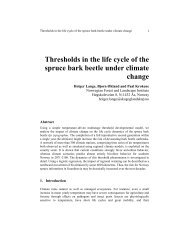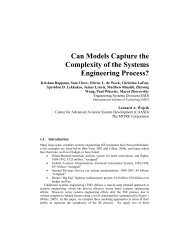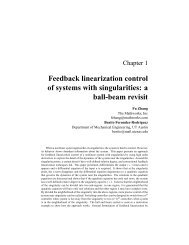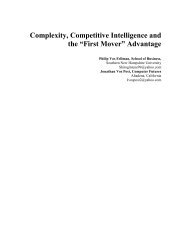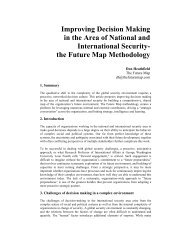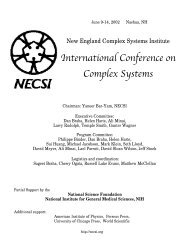Modularity and Self-Organized Functional Architectures in the Brain
Modularity and Self-Organized Functional Architectures in the Brain
Modularity and Self-Organized Functional Architectures in the Brain
Create successful ePaper yourself
Turn your PDF publications into a flip-book with our unique Google optimized e-Paper software.
<strong>Modularity</strong> <strong>and</strong><br />
<strong>Self</strong>-<strong>Organized</strong> <strong>Functional</strong><br />
<strong>Architectures</strong> <strong>in</strong> <strong>the</strong> Bra<strong>in</strong><br />
Laxmi Iyer <strong>and</strong> Ali A. M<strong>in</strong>ai<br />
University of C<strong>in</strong>c<strong>in</strong>nati<br />
iyerlr@email.uc.edu<br />
Ali.M<strong>in</strong>ai@uc.edu<br />
Simona Doboli <strong>and</strong> V<strong>in</strong>cent R. Brown<br />
Hofstra University<br />
Simona.Doboli@hofstra.edu<br />
V<strong>in</strong>cent.R.Brown@hofstra.edu<br />
It is generally believed that cognition <strong>in</strong>volves <strong>the</strong> self-organization of coherent dynamic<br />
functional networks across several bra<strong>in</strong> regions <strong>in</strong> response to <strong>in</strong>com<strong>in</strong>g stimulus<br />
<strong>and</strong> <strong>in</strong>ternal modulation. These context-dependent networks arise cont<strong>in</strong>ually from <strong>the</strong><br />
spatiotemporally multi-scale structural substrate of <strong>the</strong> bra<strong>in</strong> configured by evolution,<br />
development <strong>and</strong> previous experience, persist<strong>in</strong>g for 100-200 ms <strong>and</strong> generat<strong>in</strong>g responses<br />
such as imagery, recall <strong>and</strong> motor action. In <strong>the</strong> current paper, we show that<br />
a system of <strong>in</strong>teract<strong>in</strong>g modular attractor networks can use a selective mechanism for<br />
assembl<strong>in</strong>g functional networks from <strong>the</strong> modular substrate. We use <strong>the</strong> approach to<br />
develop a model of idea-generation <strong>in</strong> <strong>the</strong> bra<strong>in</strong>. Ideas are modeled as comb<strong>in</strong>ations of<br />
concepts organized <strong>in</strong> a recurrent network that reflects previous associations between<br />
<strong>the</strong>m. The dynamics of this network, result<strong>in</strong>g <strong>in</strong> <strong>the</strong> transient co-activation of concept<br />
groups, is seen as a search through <strong>the</strong> space of ideas, <strong>and</strong> attractor dynamics is used<br />
to “shape” this search. The process is required to encompass both rapid retrieval of<br />
old ideas <strong>in</strong> familiar contexts <strong>and</strong> efficient search for novel ones <strong>in</strong> unfamiliar situations<br />
(or dur<strong>in</strong>g bra<strong>in</strong>storm<strong>in</strong>g). The <strong>in</strong>clusion of an adaptive modulatory mechanism allows<br />
<strong>the</strong> network to balance <strong>the</strong> compet<strong>in</strong>g requirements of exploit<strong>in</strong>g previous learn<strong>in</strong>g <strong>and</strong><br />
explor<strong>in</strong>g new possibilities as needed <strong>in</strong> different contexts.
1 Introduction<br />
A consensus is gradually develop<strong>in</strong>g that cognition <strong>in</strong>volves <strong>the</strong> cont<strong>in</strong>ual selforganization<br />
<strong>and</strong> dissipation of functional networks across several bra<strong>in</strong> regions<br />
– especially <strong>the</strong> neocortex – <strong>in</strong> response to <strong>in</strong>com<strong>in</strong>g stimulus <strong>and</strong> <strong>in</strong>ternal modulation<br />
[25, 19, 18, 21, 23, 42, 3, 37]. Each functional network emerges from <strong>the</strong><br />
bra<strong>in</strong>’s substrate <strong>in</strong> response to contextual <strong>in</strong>formation, persists while <strong>the</strong> context<br />
applies, <strong>and</strong> <strong>the</strong>n dissolves back <strong>in</strong>to <strong>the</strong> substrate to allow a new network<br />
– or networks – to emerge.<br />
As po<strong>in</strong>ted out by Doyle <strong>and</strong> colleagues [8, 7], useful systems are typically<br />
heterogeneous <strong>and</strong> specific ra<strong>the</strong>r than homogeneous <strong>and</strong> generic. The configuration<br />
of such specific heterogeneity usually requires optimization, but that is not<br />
feasible <strong>in</strong> real-time for a complex system like <strong>the</strong> bra<strong>in</strong>. Instead, such systems<br />
must work through self-organization aris<strong>in</strong>g naturally from <strong>the</strong> structure <strong>and</strong><br />
dynamics of <strong>the</strong> system. However, rapid self-organization of functional networks<br />
is only possible <strong>in</strong> <strong>the</strong> bra<strong>in</strong> if it provides <strong>the</strong> structure <strong>and</strong> mechanisms that<br />
facilitate <strong>the</strong> process – <strong>and</strong> it does! The cortex is organized <strong>in</strong>to modules called<br />
cortical columns that group toge<strong>the</strong>r <strong>in</strong>to larger modules termed hypercolumns<br />
[28]. Such modularity is a fundamental enabl<strong>in</strong>g mechanism for self-organized<br />
complexity <strong>in</strong> liv<strong>in</strong>g systems [38], <strong>and</strong> provides exactly <strong>the</strong> sort of flexibility that<br />
is needed for efficient reconfiguration of functional networks.<br />
We postulate that five factors comb<strong>in</strong>e to produce <strong>the</strong> emergence of effective,<br />
flexible, robust <strong>and</strong> reliable functional networks <strong>in</strong> <strong>the</strong> bra<strong>in</strong>. These are:<br />
1. A modular substrate with sufficient diversity: The underly<strong>in</strong>g network,<br />
which is configured over <strong>the</strong> multiple time-scales of evolution, development<br />
<strong>and</strong> experiential learn<strong>in</strong>g, provides modules with a wide variety of<br />
functional micro-behaviors.<br />
2. A dynamic selective process to b<strong>in</strong>d functional structures: This process<br />
selectively comb<strong>in</strong>es an appropriate set of modules so that <strong>the</strong> correct<br />
macro-functionality emerges from <strong>the</strong> <strong>in</strong>teraction of <strong>the</strong>ir micro-behaviors<br />
[4].<br />
3. A dynamic modulatory process to control scope <strong>and</strong> switch<strong>in</strong>g: This process<br />
modulates <strong>the</strong> excitability of neural units to determ<strong>in</strong>e which ones<br />
participate <strong>in</strong> <strong>the</strong> current functional network, thus controll<strong>in</strong>g <strong>the</strong> effective<br />
breadth of <strong>the</strong>se networks, <strong>and</strong> <strong>the</strong> transition between networks.<br />
4. An evaluative feedback process: This provides a re<strong>in</strong>forcement signal back<br />
to <strong>the</strong> system so that it can appropriate functional networks can be configured<br />
<strong>and</strong> triggered.<br />
5. A repertoire of learn<strong>in</strong>g processes: These <strong>in</strong>clude: a) <strong>Self</strong>-organization<br />
of micro-behaviors <strong>in</strong> modules to provide a good behavioral basis; b)<br />
Re<strong>in</strong>forcement-driven Hebbian learn<strong>in</strong>g to associate contexts with appropriate<br />
functional networks; c) Re<strong>in</strong>forcement-driven Hebbian learn<strong>in</strong>g to
configure <strong>the</strong> <strong>in</strong>teractions among modules so that useful functional networks<br />
become embedded <strong>in</strong> <strong>the</strong> substrate through self-organization.<br />
In order to study <strong>the</strong>se pr<strong>in</strong>ciples <strong>in</strong> a concrete, albeit much simplified, framework,<br />
we consider a model for idea generation <strong>in</strong> a neural system.<br />
A major motivation for <strong>the</strong> development of <strong>the</strong> model presented here is our<br />
goal to develop a detailed, neurally plausible model of <strong>the</strong> process of creative idea<br />
generation commonly called ‘bra<strong>in</strong>storm<strong>in</strong>g’. Bra<strong>in</strong>storm<strong>in</strong>g refers to idea generation<br />
under specific guidel<strong>in</strong>es designed to promote quantity <strong>and</strong> creativity with<br />
m<strong>in</strong>imal censorship <strong>and</strong> criticism [32]. Although <strong>the</strong>se guidel<strong>in</strong>es were designed<br />
for use <strong>in</strong> groups, <strong>in</strong>dividuals can obviously engage <strong>in</strong> creative idea generation as<br />
well. In fact <strong>the</strong> vast majority of laboratory research on bra<strong>in</strong>storm<strong>in</strong>g f<strong>in</strong>ds that<br />
an equal number of solitary bra<strong>in</strong>stormers outperform <strong>in</strong>teractive groups by almost<br />
a 2 to 1 marg<strong>in</strong> when quantity of ideas is counted [13, 29, 35]. None<strong>the</strong>less<br />
be<strong>in</strong>g exposed to <strong>the</strong> ideas of o<strong>the</strong>rs can be stimulat<strong>in</strong>g <strong>and</strong>, under conditions<br />
designed to reduce social <strong>in</strong>hibition, groups can match or exceed <strong>the</strong> performance<br />
of an equal number of solitary bra<strong>in</strong>stormers, thus clos<strong>in</strong>g or elim<strong>in</strong>at<strong>in</strong>g<br />
<strong>the</strong> ‘group productivity gap’ [33, 36]. Theoretically groups provide <strong>the</strong> stimulation<br />
necessary to get <strong>in</strong>dividuals “out of a rut” by activat<strong>in</strong>g less accessible<br />
categories of ideas <strong>and</strong> activat<strong>in</strong>g atypical sequences of ideas that can be fuel for<br />
novel conceptual comb<strong>in</strong>ations [6, 30]. There is accumulat<strong>in</strong>g evidence for <strong>the</strong><br />
stimulat<strong>in</strong>g effects of <strong>the</strong> exposure to o<strong>the</strong>rs’ ideas [10, 16, 26] (although see Nijstad<br />
et al. [31] for evidence that exposure to o<strong>the</strong>r ideas can also have <strong>in</strong>terfer<strong>in</strong>g<br />
effects on bra<strong>in</strong>storm<strong>in</strong>g). Recent models based on bra<strong>in</strong>storm<strong>in</strong>g as activation,<br />
search, <strong>and</strong> recall of ideas <strong>in</strong> associative memory can account for a number of<br />
<strong>the</strong>se empirical results <strong>and</strong> have proven fruitful <strong>in</strong> generat<strong>in</strong>g testable hypo<strong>the</strong>sis<br />
about a number of important cognitive processes <strong>in</strong>volved <strong>in</strong> bra<strong>in</strong>storm<strong>in</strong>g,<br />
<strong>in</strong>clud<strong>in</strong>g attention, work<strong>in</strong>g memory, memory accessibility, <strong>and</strong> convergent vs.<br />
divergent th<strong>in</strong>k<strong>in</strong>g [6, 34, 30]. One major limitation of <strong>the</strong>se models is <strong>the</strong> <strong>in</strong>ability<br />
to account for <strong>the</strong> important process of conceptual comb<strong>in</strong>ation <strong>in</strong> generat<strong>in</strong>g<br />
creative responses. One goal of <strong>the</strong> model presented here is to provide a neurocomputational<br />
mechanism for <strong>the</strong> generation of novel conceptual comb<strong>in</strong>ations.<br />
In addition, with recent work on <strong>the</strong> neuroscience of creativity [22, 24, 15], <strong>the</strong>re<br />
is <strong>the</strong> need for more detailed neurally-<strong>in</strong>spired models of <strong>the</strong> bra<strong>in</strong>storm<strong>in</strong>g process.<br />
Prototypes of <strong>the</strong> model presented here based on <strong>the</strong> attractor network<br />
architecture have shown promise <strong>in</strong> account<strong>in</strong>g for some of <strong>the</strong> basic empirical<br />
bra<strong>in</strong>storm<strong>in</strong>g results <strong>in</strong> both <strong>in</strong>dividuals <strong>and</strong> groups [5, 14].<br />
2 Problem Formulation<br />
We beg<strong>in</strong> by postulat<strong>in</strong>g that ideas are comb<strong>in</strong>ations of concepts, which are <strong>the</strong><br />
basic representational units <strong>in</strong> our model. Novel ideas are conceptual comb<strong>in</strong>ations<br />
whose elements have not been comb<strong>in</strong>ed <strong>in</strong> <strong>the</strong> past, while groups that<br />
have been formed previously represent familiar ideas. A cognitive system must<br />
be able to retrieve familiar ideas <strong>and</strong> to generate novel ones.
Ideas always arise – <strong>and</strong> make sense – with<strong>in</strong> a context, e.g., a task situation.<br />
Each context – even if it is not completely familiar – tends to elicit a set of<br />
ideas by association <strong>and</strong> suppresses o<strong>the</strong>rs, presumably mak<strong>in</strong>g <strong>the</strong> search for<br />
useful ideas more efficient. Thus, a context, Φ, can be seen as a semantic bias<strong>in</strong>g<br />
mechanism that preferentially implicitly unmasks a subset, I Φ , of ideas from <strong>the</strong><br />
space of all ideas, allow<strong>in</strong>g a search process to explore this subset <strong>and</strong> “discover”<br />
good ideas. S<strong>in</strong>ce ideas are comb<strong>in</strong>ations of concepts, we model this process<br />
as <strong>the</strong> selective activation of a context-dependent concept network (CCN) whose<br />
states represent ideas, <strong>and</strong> whose dynamics embodies <strong>the</strong> search process. The<br />
CCN is a functional network.<br />
Ideas can be seen more broadly as <strong>in</strong>ternal responses of <strong>the</strong> cognitive system,<br />
<strong>and</strong> idea-generation is essentially no different from <strong>the</strong> generation of motor<br />
responses, memory recall or mental imagery (<strong>in</strong>deed, mental images can be regarded<br />
as ideas too!) It is well known that mental responses fall <strong>in</strong>to two broad<br />
categories: Automatic <strong>and</strong> effortful [12]. The former (automatic) are faster,<br />
stereotypical <strong>and</strong> fluent, while <strong>the</strong> latter (effortful) appear to entail some type<br />
of constructive process or search. It has been proposed that effortful responses<br />
require <strong>the</strong> <strong>in</strong>volvement of work<strong>in</strong>g memory [2] or global workspace [1], which<br />
functions essentially as a temporary “hidden layer” facilitat<strong>in</strong>g direct l<strong>in</strong>kage<br />
between stimulus <strong>and</strong> response. Once <strong>the</strong> direct l<strong>in</strong>kage is consolidated, <strong>the</strong> mediat<strong>in</strong>g<br />
process is cut out, leav<strong>in</strong>g beh<strong>in</strong>d an automatic response for <strong>the</strong> future<br />
[12]. Alternatively, work<strong>in</strong>g memory may rema<strong>in</strong> <strong>in</strong>volved <strong>in</strong> complex, contextdependent<br />
tasks — aga<strong>in</strong> as a bias<strong>in</strong>g hidden layer [27, 17, 11]. While <strong>the</strong>se<br />
abstract formulations clearly capture important elements of <strong>the</strong> phenomenology<br />
of response generation, <strong>the</strong>y represent an implicitly teleological view, where<br />
automatization of response is seen as an end towards which <strong>the</strong> mechanism of<br />
learn<strong>in</strong>g works. In contrast, we seek a neural system where <strong>the</strong> emergence of<br />
novel responses <strong>and</strong> facilitation of familiar ones both arise naturally from <strong>the</strong><br />
<strong>in</strong>tr<strong>in</strong>sic dynamics of <strong>the</strong> system. Embedded <strong>in</strong> an environment, such a system<br />
cont<strong>in</strong>ually creates responses to <strong>the</strong> <strong>in</strong>formation flow<strong>in</strong>g through it — perpetually<br />
adjust<strong>in</strong>g its <strong>in</strong>ternal constra<strong>in</strong>ts to facilitate especially useful responses.<br />
Behavior, <strong>in</strong> this view, is not a goal or a purpose of <strong>the</strong> system, but a property.<br />
In <strong>the</strong> case of idea generation, we develop a simple neural model show<strong>in</strong>g<br />
how modular organization, selectivity, modulation, evaluative feedback <strong>and</strong><br />
re<strong>in</strong>forcement-driven adaptation comb<strong>in</strong>e to produce an efficient search process<br />
through <strong>the</strong> system’s natural dynamics.<br />
3 The Idea Generation Process<br />
Search is useful only if it is efficient. Exhaustive search, while guaranteed to<br />
succeed, is typically not an option. Thus, our primary focus is on how <strong>the</strong><br />
search for ideas is shaped <strong>and</strong> guided by <strong>the</strong> system’s dynamics so that it is as<br />
broad as necessary <strong>and</strong> as narrow as possible. We only consider this criterion<br />
heuristically, <strong>and</strong> will ref<strong>in</strong>e it fur<strong>the</strong>r <strong>in</strong> future studies.<br />
Efficiency <strong>in</strong> search requires effective use of <strong>in</strong>formation. There are three
Figure 1: Architecture of <strong>the</strong> idea generation model.<br />
major sources of <strong>in</strong>formation available to guide <strong>the</strong> search for ideas <strong>in</strong> our model,<br />
<strong>and</strong> form <strong>the</strong> basis of its utility. These are:<br />
1. Current task or doma<strong>in</strong> context: The search should focus on concepts<br />
that, <strong>in</strong> comb<strong>in</strong>ation, are likely to be relevant to <strong>the</strong> context at h<strong>and</strong>. A<br />
neural system does this by associat<strong>in</strong>g context representations with specific<br />
patterns of module activation, form<strong>in</strong>g functional networks.<br />
2. Previous experience: The flow of <strong>the</strong> search should be guided, <strong>and</strong> its<br />
extent determ<strong>in</strong>ed, by <strong>the</strong> experience of <strong>the</strong> system <strong>in</strong> <strong>in</strong>ferr<strong>in</strong>g <strong>the</strong> regularities<br />
of its operat<strong>in</strong>g environment. The only way for a neural system to<br />
do this is by embedd<strong>in</strong>g such experiential knowledge <strong>in</strong> its structure <strong>and</strong><br />
dynamical parameters, so that <strong>the</strong> emergent flow of <strong>the</strong> system’s activity<br />
is appropriately constra<strong>in</strong>ed to productive regions <strong>and</strong> trajectories <strong>in</strong> <strong>the</strong><br />
search space.<br />
3. The progress of <strong>the</strong> search so far: As <strong>the</strong> search proceeds, it should be<br />
guided cont<strong>in</strong>ually by <strong>the</strong> <strong>in</strong>com<strong>in</strong>g evaluative feedback towards more productive<br />
regions. This is necessary because novel ideas often require <strong>the</strong><br />
formation of functional networks o<strong>the</strong>r than those triggered <strong>in</strong>itially by<br />
<strong>the</strong> context. This can only happen if feedback can overcome <strong>the</strong> <strong>in</strong>itial<br />
bias <strong>and</strong> create new structures <strong>in</strong> a systematic way – aga<strong>in</strong>, guided by <strong>the</strong><br />
experiential knowledge implicit <strong>in</strong> <strong>the</strong> system’s structure.<br />
The primary hypo<strong>the</strong>sis beh<strong>in</strong>d our model can be stated <strong>in</strong> two parts: 1)
The <strong>in</strong>teraction between afferent context/stimulus <strong>in</strong>formation, network structure<br />
<strong>and</strong> modulation create a dynamic energy l<strong>and</strong>scape <strong>in</strong> concept space; <strong>and</strong> 2)<br />
The it<strong>in</strong>erant flow of activity over this l<strong>and</strong>scape represents <strong>the</strong> search for ideas,<br />
which are metastable attractors. Thus, <strong>the</strong> mechanisms for rapidly generat<strong>in</strong>g<br />
productive energy l<strong>and</strong>scapes <strong>in</strong> concept space is <strong>the</strong> fundamental focus of <strong>the</strong><br />
research.<br />
3.1 Convergent vs. Divergent Th<strong>in</strong>k<strong>in</strong>g<br />
An important issue <strong>in</strong> idea generation is <strong>the</strong> style of th<strong>in</strong>k<strong>in</strong>g. In <strong>the</strong> divergent<br />
th<strong>in</strong>k<strong>in</strong>g mode (or exploration), <strong>the</strong>re is some possibility that concepts or categories<br />
that are not strongly connected to each o<strong>the</strong>r normally or not strongly<br />
associated with <strong>the</strong> same context, will still become co-active, lead<strong>in</strong>g to a large<br />
number of relatively r<strong>and</strong>om comb<strong>in</strong>ations, but occasionally to useful novel associations.<br />
These useful novel associations are less likely to occur <strong>in</strong> <strong>the</strong> convergent<br />
th<strong>in</strong>k<strong>in</strong>g mode (exploitation) where <strong>the</strong> search of <strong>the</strong> conceptual space is more<br />
restricted to exist<strong>in</strong>g ideas.<br />
We hypo<strong>the</strong>size that <strong>the</strong>se differences can be understood through <strong>the</strong> dynamics<br />
of activity on <strong>the</strong> dynamic energy l<strong>and</strong>scape described above, <strong>and</strong> arise<br />
from <strong>the</strong> relative flexibility of this l<strong>and</strong>scape. A system with <strong>in</strong>sufficient modulation<br />
<strong>and</strong> short-term learn<strong>in</strong>g is only able to produce stereotypical energy<br />
l<strong>and</strong>scapes with relatively high barriers between attractors. It, <strong>the</strong>refore, tends<br />
to get trapped <strong>in</strong> suboptimal regions of search space <strong>and</strong> leads to convergent<br />
th<strong>in</strong>k<strong>in</strong>g. In contrast, a more flexible system can adapt <strong>the</strong> energy l<strong>and</strong>scape<br />
to create new attractors through <strong>the</strong> recomb<strong>in</strong>ation of old ones, thus ev<strong>in</strong>c<strong>in</strong>g<br />
divergent th<strong>in</strong>k<strong>in</strong>g.<br />
The model we develop embodies this view of idea generator, implement<strong>in</strong>g<br />
it <strong>in</strong> a connectionist framework.<br />
4 Model Description<br />
The model we propose is shown <strong>in</strong> Figure 1. It comprises <strong>the</strong> follow<strong>in</strong>g components:<br />
• A stimulus or <strong>in</strong>put layer, I, provid<strong>in</strong>g a set of n I stimulus feature units<br />
(SFUs) encod<strong>in</strong>g afferent stimuli, <strong>in</strong>clud<strong>in</strong>g context <strong>in</strong>formation.<br />
• A response layer, R, compris<strong>in</strong>g a fixed pool of n R response feature units<br />
(RFUs) denot<strong>in</strong>g response-relevant characteristics of concepts.<br />
• A concept layer, C, compris<strong>in</strong>g a pool of n C concept units (CUs). Each concept<br />
unit has connections (both excitatory <strong>and</strong> <strong>in</strong>hibitory) with a subset of<br />
RFUs, thus implicitly def<strong>in</strong><strong>in</strong>g <strong>the</strong> response semantics of <strong>the</strong> concept. The<br />
concept layer also has fast recurrent excitatory connections among concept<br />
units, which tend to stabilize specific patterns of coactive units, <strong>and</strong> slower
ecurrent self-<strong>in</strong>hibition that stochastically limits how long a unit can rema<strong>in</strong><br />
cont<strong>in</strong>uously active. These compet<strong>in</strong>g tendencies generate a flow of<br />
activity patterns — similar to it<strong>in</strong>erant dynamics over a set of metastable<br />
attractors [43] — consistent with <strong>the</strong> hypo<strong>the</strong>sis that mental constructs<br />
are represented as slightly persistent patterns of coherent cortical activity<br />
[20, 41]. The patterns of coactive concepts temporarily stabilized by<br />
fast connections represent ideas. Each idea activates <strong>the</strong> response features<br />
correspond<strong>in</strong>g to its constituent concepts, which is <strong>the</strong> effective response<br />
of <strong>the</strong> system. As a whole, <strong>the</strong> concept layer can be seen as compris<strong>in</strong>g a<br />
distributed semantic network.<br />
The pattern of recurrent connectivity with<strong>in</strong> <strong>the</strong> concept layer reflects<br />
<strong>the</strong> utility of associations between concepts based on previous experience.<br />
Thus, if CUs i <strong>and</strong> j have been coactive <strong>in</strong> several “good” ideas, <strong>the</strong>y have<br />
strong positive reciprocal connections, while <strong>the</strong> connection may be weak,<br />
non-existent or even negative if this is not <strong>the</strong> case. Thus, given <strong>the</strong> noisy<br />
activation <strong>and</strong> refractor<strong>in</strong>ess of concept units, <strong>the</strong> dynamics of <strong>the</strong> concept<br />
layer tends to stochastically reactivate attractors that are previously seen<br />
good ideas or <strong>the</strong>ir mixtures.<br />
• A category layer, G, compris<strong>in</strong>g a set of N S concept group units (CGUs)<br />
organized <strong>in</strong>to n Q cliques, {Q k }, k = 1, ..., n Q . These cliques correspond<strong>in</strong>g<br />
(roughly) to utilitarian categories. CGUs with<strong>in</strong> <strong>the</strong> same clique are<br />
(relatively) densely <strong>in</strong>terconnected by excitatory connections, while pairs<br />
of cliques are symmetrically connected by relatively sparse excitatory or <strong>in</strong>hibitory<br />
connections <strong>in</strong> a specific pattern reflect<strong>in</strong>g <strong>the</strong> system’s experience<br />
of whe<strong>the</strong>r jo<strong>in</strong>t activity by clique pairs is useful or o<strong>the</strong>rwise. Each CGU<br />
has reciprocal connections with a subset of concept units, thus def<strong>in</strong><strong>in</strong>g a<br />
conceptual group (CG) which can be seen roughly as “basis functions” for<br />
ideas. Several cliques may <strong>in</strong>clude <strong>the</strong> same CG — each associated with<br />
its own CGU, <strong>and</strong> <strong>the</strong> concepts with<strong>in</strong> a conceptual group may be quite<br />
different <strong>in</strong> terms of <strong>the</strong>ir features. The presence of two CGs <strong>in</strong> <strong>the</strong> same<br />
clique <strong>in</strong>dicate that <strong>the</strong>y have been useful toge<strong>the</strong>r <strong>in</strong> <strong>the</strong> same context at<br />
various times, imply<strong>in</strong>g that good ideas can be elicited <strong>in</strong> similar contexts<br />
simply by activat<strong>in</strong>g CGs <strong>in</strong> this clique. This utilitarian cluster<strong>in</strong>g typically<br />
means that cliques are also semantically dist<strong>in</strong>ct from each o<strong>the</strong>r,<br />
so that every clique does not <strong>in</strong>clude concepts with all possible features.<br />
Thus, while <strong>the</strong> concepts <strong>and</strong> CGs associated with a clique, Q k , are quite<br />
heterogeneous, <strong>the</strong>y cover only a subset, R k , of response features, <strong>and</strong> only<br />
a subset <strong>in</strong> <strong>the</strong> space of possible CGs.<br />
It should be noted that <strong>the</strong> modular structure imposed by layer G on<br />
layer C is consistent with but not identical to <strong>the</strong> structure implicit <strong>in</strong><br />
<strong>the</strong> recurrent connectivity of C. Concepts may be strongly connected<br />
even if <strong>the</strong>y do not share a clique if <strong>the</strong>y have been part of good ideas<br />
<strong>in</strong> <strong>the</strong> past. Over time, learn<strong>in</strong>g should adjust clique memberships <strong>and</strong><br />
conceptual groups to remove this “mismatch”, but <strong>the</strong> current model does
not address that issue yet.<br />
• A critic, Ψ, that takes <strong>in</strong>put from layer R <strong>and</strong> compares <strong>the</strong> activity pattern<br />
of this layer with an <strong>in</strong>ternally stored criterion pattern of features,<br />
generat<strong>in</strong>g a graded scalar response evaluation. This response evaluation<br />
is used as feedback by <strong>the</strong> system to modulate its parameters, <strong>and</strong> to<br />
control learn<strong>in</strong>g. The critic is <strong>in</strong>tended to be a phenomenological model<br />
of <strong>in</strong>ternal <strong>and</strong> external evaluative mechanisms (e.g., a dopam<strong>in</strong>e signal<br />
triggered by a re<strong>in</strong>forcement signal [40, 39]).<br />
Afferent <strong>in</strong>put from <strong>the</strong> stimulus layer drives all three layers through modifiable<br />
connections. The category layer is also subject to adaptive <strong>in</strong>hibitory<br />
modulation, which controls <strong>the</strong> total amount of activity allowed <strong>in</strong> <strong>the</strong> layer.<br />
Competitive <strong>in</strong>hibition <strong>in</strong> <strong>the</strong> concept layer also constra<strong>in</strong>s <strong>the</strong> number of simultaneously<br />
active concept units.<br />
5 System <strong>Functional</strong>ity<br />
As discussed earlier, <strong>the</strong> system’s response is generated through a transiently<br />
stable (metastable) spatiotemporal pattern of activity spann<strong>in</strong>g <strong>the</strong> whole system<br />
— a reverberatory (or resonant) [9] pattern <strong>in</strong>volv<strong>in</strong>g <strong>the</strong> category, concept<br />
<strong>and</strong> response layers. However, it is specifically <strong>the</strong> activity of <strong>the</strong> concept layer<br />
that represents <strong>the</strong> system’s <strong>in</strong>ternal response at <strong>the</strong> level of ideas. This response<br />
is projected <strong>in</strong>to <strong>the</strong> common semantic space spanned by <strong>the</strong> response<br />
features, where it can be evaluated. These features can thus be seen as “<strong>in</strong>ternal<br />
actuators”, or as verbalization components. Given a context (<strong>and</strong> possibly<br />
a stimulus stream), <strong>the</strong> goal is to generate responses that meet <strong>the</strong> functional<br />
criteria known to <strong>the</strong> critic as efficiently, rapidly, <strong>and</strong> copiously as possible.<br />
Process<strong>in</strong>g starts when <strong>the</strong> system is stimulated by a context stimulus, Φ j<br />
through layer S. This results <strong>in</strong> <strong>the</strong> activation of one or more cliques <strong>in</strong> G based<br />
on <strong>the</strong> association between <strong>the</strong> stimulus pattern <strong>and</strong> CGUs, <strong>and</strong> creates a stable<br />
activation pattern <strong>in</strong> layer G that persists even after <strong>the</strong> context stimulus is<br />
removed. This G-layer activity projects a selective bias onto Layer C, creat<strong>in</strong>g<br />
an implicit energy l<strong>and</strong>scape <strong>in</strong> concept space with ideas as attractors. However,<br />
s<strong>in</strong>ce only a small number of CUs can be co-active <strong>and</strong> <strong>in</strong>dividual CUs can rema<strong>in</strong><br />
active only for limited durations, <strong>the</strong> energy l<strong>and</strong>scape keeps chang<strong>in</strong>g as ideas<br />
emerge, persist for a brief time, <strong>and</strong> dissolve. This “sticky” flow of ideas <strong>in</strong> C is<br />
<strong>the</strong> search process shaped by <strong>the</strong> <strong>in</strong>teraction of bias from G <strong>and</strong> <strong>the</strong> recurrent<br />
connectivity <strong>in</strong> C.<br />
As ideas are produced, <strong>the</strong>y generate a stream of evaluations, φ(t), through<br />
<strong>the</strong> critic. This is <strong>in</strong>tegrated by a low-pass filter<br />
¯φ(t) = αφ(t) + (1 − α) ¯φ(t − 1); 0 < α < 1<br />
<strong>and</strong> modulates <strong>the</strong> <strong>in</strong>hibition level on layer G. As ¯φ(t) becomes lower (because<br />
no good responses have been found), <strong>in</strong>hibition on G is also lowered,
eventually lead<strong>in</strong>g to <strong>the</strong> activation of more cliques <strong>and</strong> <strong>the</strong>ir CGs. This changes<br />
<strong>the</strong> bias on Layer C <strong>and</strong>, <strong>the</strong>refore, <strong>the</strong> energy l<strong>and</strong>scape for <strong>the</strong> flow of ideas.<br />
The order <strong>in</strong> which new cliques are activated as <strong>in</strong>hibition is lowered is robustly<br />
dependent on two factors:<br />
1. The orig<strong>in</strong>al context stimulus, which determ<strong>in</strong>ed <strong>the</strong> orig<strong>in</strong>al clique activity<br />
pattern.<br />
2. The <strong>in</strong>ter-clique connectivity reflect<strong>in</strong>g <strong>the</strong> expected utility of co-activat<strong>in</strong>g<br />
certa<strong>in</strong> cliques (or CGUs with<strong>in</strong> cliques).<br />
This broaden<strong>in</strong>g of <strong>the</strong> search for ideas is useful, but is not likely to be very<br />
efficient without a concurrent process for narrow<strong>in</strong>g <strong>the</strong> search so it can focus<br />
<strong>in</strong> more productive regions of idea space. This is achieved us<strong>in</strong>g feedback from<br />
<strong>the</strong> concept layer to <strong>the</strong> category layer. As <strong>the</strong> search is widened <strong>and</strong> some good<br />
ideas start appear<strong>in</strong>g, this results <strong>in</strong> a gradual <strong>in</strong>crease <strong>in</strong> ¯φ, which <strong>the</strong>n tries to<br />
decrease <strong>the</strong> activity <strong>in</strong> G. Also, each time a good idea is rewarded sufficiently,<br />
two processes are triggered:<br />
1. Short-term performance-dependent reorganization of G-layer connectivity:<br />
The reward signal causes <strong>the</strong> connections from <strong>the</strong> concept layer to <strong>the</strong><br />
category layer to be transiently, but strongly, potentiated (shown by <strong>the</strong><br />
gate <strong>in</strong> Figure 1). Thus, <strong>the</strong> concept units active at <strong>the</strong> time of <strong>the</strong> reward<br />
(which presumably comprised <strong>the</strong> good idea) send an unusually strong<br />
excitation to <strong>the</strong> CGUs active at <strong>the</strong> same time, which respond to this<br />
jolt by fir<strong>in</strong>g strongly (e.g., burst<strong>in</strong>g). This, <strong>in</strong> turn, leads to short-term<br />
synaptic potentiation of connections between burst<strong>in</strong>g units [18], <strong>and</strong> a<br />
short-term depression of connections between burst<strong>in</strong>g <strong>and</strong> non-burst<strong>in</strong>g<br />
units. The net result is that Layer G units project<strong>in</strong>g to concepts <strong>in</strong> good<br />
ideas become relatively more strongly connected to each o<strong>the</strong>r, as do <strong>the</strong><br />
cliques <strong>in</strong> which <strong>the</strong>y reside, thus chang<strong>in</strong>g <strong>the</strong> G-layer connectivity to<br />
reflect recent experience.<br />
2. Permanent performance-based change <strong>in</strong> association between concepts: The<br />
reward signal causes <strong>the</strong> concept units active at <strong>the</strong> time of <strong>the</strong> reward to<br />
permanently streng<strong>the</strong>n <strong>the</strong>ir excitatory connectivity.<br />
The effect of (2) is that good ideas become more embedded <strong>in</strong> <strong>the</strong> concept<br />
layer, which makes <strong>the</strong>m likelier to arise <strong>in</strong> <strong>the</strong> future. The effect of (1) is more<br />
pert<strong>in</strong>ent to <strong>the</strong> current search. The change <strong>in</strong> G-layer connectivity means that<br />
<strong>the</strong> cliques likely to survive <strong>the</strong> process of <strong>in</strong>creas<strong>in</strong>g <strong>in</strong>hibition due to greater<br />
reward are not necessarily those orig<strong>in</strong>ally activated by <strong>the</strong> context, but those<br />
responsible for <strong>the</strong> recent good ideas. If more good ideas are forthcom<strong>in</strong>g from<br />
this restricted set of cliques, <strong>the</strong> system will go on restrict<strong>in</strong>g <strong>the</strong> search fur<strong>the</strong>r.<br />
If <strong>the</strong> process becomes too restrictive (<strong>and</strong> good ideas cease), <strong>in</strong>hibition will<br />
drop aga<strong>in</strong> <strong>and</strong> <strong>the</strong> search will widen. However, <strong>the</strong> pattern of widen<strong>in</strong>g will be<br />
affected by <strong>the</strong> recent experience of <strong>the</strong> system because <strong>the</strong> orig<strong>in</strong>al <strong>in</strong>ter-clique
connectivity has been modified (transiently) by this experience. Eventually, <strong>the</strong><br />
system will reach a stage where a set of cliques dense <strong>in</strong> good ideas is activated,<br />
so that <strong>the</strong> <strong>in</strong>creased re<strong>in</strong>forcement susta<strong>in</strong>s this set even at maximum<br />
<strong>in</strong>hibition. Basically, <strong>the</strong> system has arrived at <strong>the</strong> best set of cliques – <strong>and</strong><br />
thus <strong>the</strong> best pool of ideas – through a process of “<strong>in</strong>telligent anneal<strong>in</strong>g” that<br />
takes <strong>in</strong>to account <strong>the</strong> current context, <strong>the</strong> system’s past experience, <strong>and</strong> <strong>the</strong><br />
results of <strong>the</strong> system’s current search. This discovered set of cliques <strong>and</strong>/or concepts/ideas<br />
can be associated with <strong>the</strong> orig<strong>in</strong>al context, <strong>and</strong> slightly change <strong>the</strong><br />
<strong>in</strong>ter-clique connectivity to reflect <strong>the</strong> new discovery. More significant changes<br />
such as realignment of clique membership are left for <strong>the</strong> future.<br />
6 Results<br />
50<br />
Category Units<br />
100<br />
150<br />
200<br />
10 20 30 40 50 60 70 80<br />
Slow Time Steps<br />
100<br />
Concept Units<br />
200<br />
300<br />
400<br />
500<br />
1000 2000 3000 4000 5000 6000 7000 8000<br />
Fast Time Steps<br />
1<br />
Reward<br />
0<br />
0 10 20 30 40 50 60 70 80<br />
Slow Time Steps<br />
Figure 2: Simulation of <strong>the</strong> search process.<br />
A somewhat simplified version of <strong>the</strong> model described above has been implemented,<br />
<strong>and</strong> search processes simulated us<strong>in</strong>g this model. The ma<strong>in</strong> simplification<br />
<strong>in</strong> <strong>the</strong> simulations is that each concept is typically associated with CGs<br />
from only one or two cliques. The cliques <strong>the</strong>mselves are connected but nonoverlapp<strong>in</strong>g<br />
(i.e., <strong>the</strong>y do not share CGs), <strong>and</strong> both category <strong>and</strong> concept layer<br />
units are arranged such that units associated with <strong>the</strong> same clique are plotted<br />
toge<strong>the</strong>r <strong>in</strong> figures. The dynamics of <strong>the</strong> simulated network <strong>in</strong>corporates two
Time steps 6400−6500<br />
50<br />
100<br />
150<br />
Concept Units<br />
200<br />
250<br />
300<br />
350<br />
400<br />
450<br />
500<br />
6410 6420 6430 6440 6450 6460 6470 6480 6490 6500<br />
Fast Time Steps<br />
Time steps 7900−8000<br />
50<br />
100<br />
150<br />
Concept Units<br />
200<br />
250<br />
300<br />
350<br />
400<br />
450<br />
500<br />
7910 7920 7930 7940 7950 7960 7970 7980 7990 8000<br />
Fast Time Steps<br />
Figure 3: Simulation of <strong>the</strong> search process.<br />
time-scales: A slow scale over which <strong>the</strong> CG activations are updated, <strong>and</strong> a fast<br />
scale used to update <strong>the</strong> concept units. Thus, each cycle of G layer update embeds<br />
100 steps of <strong>the</strong> fast cycle. Each concept unit, however, can only be active<br />
for a r<strong>and</strong>om duration between 4 <strong>and</strong> 8 fast steps, <strong>and</strong> must <strong>the</strong>n be refractory<br />
for a similar r<strong>and</strong>om duration. This allows for <strong>the</strong> context-dependent it<strong>in</strong>erant<br />
dynamics to emerge <strong>in</strong> concept space.<br />
Figure 2 shows an example run of <strong>the</strong> simulator. The G layer has 10 cliques<br />
of 20 units each, while <strong>the</strong> C layer has 500 concept units. The system emulates<br />
a situation where good ideas arise preferentially from concepts associated with<br />
cliques 3, 6 <strong>and</strong> 10 toge<strong>the</strong>r. The search starts by activat<strong>in</strong>g clique 6, <strong>and</strong> gradually<br />
discovers <strong>the</strong> right comb<strong>in</strong>ation of cliques through <strong>the</strong> process described<br />
above. At that po<strong>in</strong>t, rewards become much more dense <strong>in</strong> time, <strong>in</strong>dicat<strong>in</strong>g<br />
success.<br />
Figure 3 shows a close-up view of <strong>the</strong> concept layer dynamics at different<br />
stages of <strong>the</strong> search process. The it<strong>in</strong>erant dynamics across idea space can be<br />
seen clearly.
7 Conclusions<br />
The model described <strong>in</strong> this paper embodies a general, complex systems approach<br />
to idea generation <strong>and</strong> cognitive response – albeit <strong>in</strong> a simplified way.<br />
Our results show that <strong>the</strong> model is capable of perform<strong>in</strong>g an <strong>in</strong>telligent search<br />
<strong>in</strong> idea space through its <strong>in</strong>herent dynamics, <strong>and</strong> can represent <strong>the</strong> convergent<br />
<strong>and</strong> divergent modes of th<strong>in</strong>k<strong>in</strong>g.<br />
A major motivations for <strong>the</strong> current model is to provide a better underst<strong>and</strong><strong>in</strong>g<br />
of <strong>the</strong> cognitive, computational <strong>and</strong> neural processes underly<strong>in</strong>g “bra<strong>in</strong>storm<strong>in</strong>g”,<br />
i.e., idea generation by <strong>in</strong>dividuals <strong>in</strong>teract<strong>in</strong>g <strong>in</strong> a group accord<strong>in</strong>g<br />
to specific guidel<strong>in</strong>es. Two mechanisms whereby groups may lead to improved<br />
idea generation are <strong>the</strong> prim<strong>in</strong>g of low-accessibility categories <strong>and</strong> <strong>the</strong> facilitation<br />
of novel conceptual comb<strong>in</strong>ations. Both of <strong>the</strong>se mechanisms are <strong>in</strong>herent<br />
<strong>in</strong> <strong>the</strong> framework described here, <strong>and</strong> our model will be used to explore <strong>the</strong>se<br />
issues <strong>in</strong> a systematic fashion.<br />
Acknowledgements: The authors wish to thank Paul Paulus <strong>and</strong><br />
Daniel Lev<strong>in</strong>e for useful ideas <strong>and</strong> <strong>in</strong>sights. This work was partially supported<br />
by <strong>the</strong> National Science Foundation through award nos. BCS-<br />
0728413/0729470/0729305 to Ali M<strong>in</strong>ai, V<strong>in</strong>cent Brown <strong>and</strong> Paul Paulus. Partial<br />
support also came from <strong>the</strong> Deputy Director of National Intelligence for<br />
Analysis.<br />
Bibliography<br />
[1] Baars, B.J., <strong>and</strong> S. Frankl<strong>in</strong>, “How conscious experience <strong>and</strong> work<strong>in</strong>g<br />
memory <strong>in</strong>teract”, Trends <strong>in</strong> Cognitive Sciences 7 (2003), 166–172.<br />
[2] Baddeley, A., Work<strong>in</strong>g Memory, Oxford University Press, New York<br />
(1986).<br />
[3] Bressler, S.L., <strong>and</strong> E. Tognoli, “Operational pr<strong>in</strong>ciples of neurocognitive<br />
networks”, International Journal of Psychophysiology 60 (2006),<br />
139–148.<br />
[4] Brooks, R.A., Cambrian Intelligence: The Early History of <strong>the</strong> New AI,<br />
MIT Press (1999).<br />
[5] Brown, V., <strong>and</strong> S. Doboli, “A neural network simulation of <strong>in</strong>teractive<br />
group bra<strong>in</strong>storm<strong>in</strong>g”, Eighteenth Annual Convention of <strong>the</strong> Association<br />
for Psychological Science.<br />
[6] Brown, V., M. Tumeo, T. Larey, <strong>and</strong> P. Paulus, “Model<strong>in</strong>g cognitive<br />
<strong>in</strong>teractions dur<strong>in</strong>g group bra<strong>in</strong>storm<strong>in</strong>g”, Small Group Research 29 (1998),<br />
495–526.<br />
[7] Carlson, J.M., <strong>and</strong> J. Doyle, “Highly optimized tolerance: Robustness<br />
<strong>and</strong> design <strong>in</strong> complex systems”, Physical Review Letters 84 (2000), 2529–<br />
2532.
[8] Carlson, J.M., <strong>and</strong> J. Doyle, “Complexity <strong>and</strong> robustness”, Proceed<strong>in</strong>gs<br />
of <strong>the</strong> National Academy of Sciences USA 99 Suppl. 1 (2002), 2539–2545.<br />
[9] Carpenter, G.A., <strong>and</strong> S. Grossberg, “A massively parallel architecture<br />
for a self-organiz<strong>in</strong>g neural pattern recognition mach<strong>in</strong>e”, Computer Vision,<br />
Graphics, <strong>and</strong> Image Process<strong>in</strong>g 37 (1987), 54–115.<br />
[10] Coskun, H., Paulus, V. P.B., Brown, <strong>and</strong> J.J. Sherwood, “Cognitive<br />
stimulation <strong>and</strong> problem presentation <strong>in</strong> idea generation groups”, Group<br />
Dynamics: Theory, Research, <strong>and</strong> Practice 4 (2000), 307–329.<br />
[11] Deco, G, <strong>and</strong> E.T. Rolls, “Attention, short-term memory, <strong>and</strong> action<br />
selection: A unify<strong>in</strong>g <strong>the</strong>ory”, Progress <strong>in</strong> Neurobiology 76 (2005), 236–<br />
256.<br />
[12] Dehaene, S., M. Kerszberg, <strong>and</strong> J.-P. Changeux, “A neuronal model of<br />
a global workspace <strong>in</strong> effortful cognitive tasks”, Proceed<strong>in</strong>gs of <strong>the</strong> National<br />
Academy of Sciences, USA 95 (1998), 14529–14534.<br />
[13] Diehl, M., <strong>and</strong> W. Stroebe, “Productivity loss <strong>in</strong> bra<strong>in</strong>storm<strong>in</strong>g groups:<br />
Toward <strong>the</strong> solution of a riddle”, Journal of Personality <strong>and</strong> Social Psychology<br />
53 (1987), 497–509.<br />
[14] Doboli, S., A.A. M<strong>in</strong>ai, <strong>and</strong> V.R. Brown, “Adaptive dynamic modularity<br />
<strong>in</strong> a connectionist model of context-dependent idea generation”, Proceed<strong>in</strong>gs<br />
of <strong>the</strong> International Jo<strong>in</strong>t Conference on Neural Networks, (2007).<br />
[15] Duch, W., “Intuition, <strong>in</strong>sight, imag<strong>in</strong>ation <strong>and</strong> creativity”, IEEE Computational<br />
Intelligence Magaz<strong>in</strong>e (August 2007), 40–52.<br />
[16] Dugosh, K.L., <strong>and</strong> P.B. Paulus, “Cognitive <strong>and</strong> social comparison processes<br />
<strong>in</strong> bra<strong>in</strong>storm<strong>in</strong>g”, Journal of Experimental Social Psychology 41<br />
(2005), 313–320.<br />
[17] Duncan, J., “An adaptive cod<strong>in</strong>g model of neural function <strong>in</strong> prefrontal<br />
cortex”, Nature Reviews: Neuroscience 2 (2001), 820–829.<br />
[18] Edelman, G.M., <strong>and</strong> G. Tononi, A Universe of Consciousness: How<br />
Matter Becomes Imag<strong>in</strong>ation, Basic Books (2000).<br />
[19] Freeman, W.J., How Bra<strong>in</strong>s Make Up Their M<strong>in</strong>ds, Columbia University<br />
Press (2000).<br />
[20] Freeman, W.J., “Cortical aperiodic shutter enabl<strong>in</strong>g phase transitions at<br />
<strong>the</strong>ta rates”, Proceed<strong>in</strong>gs of <strong>the</strong> International Jo<strong>in</strong>t Conference on Neural<br />
Networks, (2007).<br />
[21] Fuster, J.M., Cortex <strong>and</strong> M<strong>in</strong>d: Unify<strong>in</strong>g Cognition, Oxford University<br />
Press (2003).
[22] Heilman, K.M., S.E. Nadeau, <strong>and</strong> D.O. Beversdorf, “Creative <strong>in</strong>novation:<br />
Possible bra<strong>in</strong> mechanisms”, Neurocase 9 (2003), 369–379.<br />
[23] Izhikevich, E.M., Dynamical Systems <strong>in</strong> Neuroscience: The Geometry of<br />
Excitability <strong>and</strong> Burst<strong>in</strong>g, MIT Press (2007).<br />
[24] Jung-Beeman, M., E.M. Bowden, J. Heberman, J.L. Frymaire,<br />
S. Arambel-Liu, R. Greenblatt, P.J. Reber, <strong>and</strong> J. Kounios, “Neural<br />
activity when people solve verbal problems with <strong>in</strong>sight”, PLoS Biology<br />
2 (2004), 500–510.<br />
[25] Kelso, J.A.S., Dynamic Patterns: The <strong>Self</strong>-Organization of Bra<strong>in</strong> <strong>and</strong><br />
Behavior, Cambridge, MA: MIT Press (1995).<br />
[26] Leggett, K.L., “The effectiveness of categorical prim<strong>in</strong>g <strong>in</strong> bra<strong>in</strong>storm<strong>in</strong>g”<br />
(1997).<br />
[27] Miller, E.K., “The prefrontal cortex <strong>and</strong> cognitive control”, Nature Reviews:<br />
Neuroscience 1 (2000), 59–65.<br />
[28] Mountcastle, V.B., “The columnar organization of <strong>the</strong> neocortex”, Bra<strong>in</strong><br />
120 (1997), 701–722.<br />
[29] Mullen, B., C. Johnson, <strong>and</strong> E. Salas, “Productivity loss <strong>in</strong> bra<strong>in</strong>storm<strong>in</strong>g<br />
groups: A meta-analytic <strong>in</strong>tegration”, Basic <strong>and</strong> Applied Social<br />
Psychology 12 (1991), 3–23.<br />
[30] Nijstad, B.A., <strong>and</strong> W. Stroebe, “How <strong>the</strong> group affects <strong>the</strong> m<strong>in</strong>d: A<br />
cognitive model of idea generation <strong>in</strong> groups”, Personality <strong>and</strong> Social Psychology<br />
Review 3 (2006), 186–213.<br />
[31] Nijstad, B.A., W. Stroebe, <strong>and</strong> H.F.M. Lodewijkx, “Cognitive stimulation<br />
<strong>and</strong> <strong>in</strong>terference <strong>in</strong> groups: Exposure effects <strong>in</strong> an idea generat<strong>in</strong>g<br />
task”, Journal of Experimental Social Psychology 38 (2002), 535–544.<br />
[32] Osborn, A.F., Applied Imag<strong>in</strong>ation, New York: Scribner’s (1957).<br />
[33] Paulus, P., <strong>and</strong> V. Brown, “Dennis, a.r. <strong>and</strong> williams, m.l.”, Group<br />
Creativity, (P. Paulus <strong>and</strong> B. Nijstad eds.). Oxford University Press<br />
New York (2003), pp. 160–178.<br />
[34] Paulus, P., <strong>and</strong> V. Brown, “Enhanc<strong>in</strong>g ideational creativity <strong>in</strong> groups:<br />
Lessons from research on bra<strong>in</strong>storm<strong>in</strong>g”, Group Creativity, (P. Paulus<br />
<strong>and</strong> B. Nijstad eds.). Oxford University Press New York (2003), pp. 110–<br />
136.<br />
[35] Paulus, P.B., <strong>and</strong> M.T. Dz<strong>in</strong>dolet, “Social <strong>in</strong>fluence processes <strong>in</strong> group<br />
bra<strong>in</strong>storm<strong>in</strong>g”, Journal of Personality <strong>and</strong> Social Psychology 64 (1993),<br />
575–586.
[36] Paulus, P.B., <strong>and</strong> H.C. Yang, “Idea generation <strong>in</strong> groups: A basis for<br />
creativity <strong>in</strong> organizations”, Organizational Behavior <strong>and</strong> Human Decision<br />
Processes 82 (2000), 76–87.<br />
[37] Perlovsky, L.I., <strong>and</strong> R. (eds.) Kozma, Neurodynamics of Cognition <strong>and</strong><br />
Consciousness, Sp<strong>in</strong>ger (2007).<br />
[38] Schlosser, G., <strong>and</strong> G.P. Wagner (eds.), <strong>Modularity</strong> <strong>in</strong> Development<br />
<strong>and</strong> Evolution, University of Chicago Press, Chicago, IL (2004).<br />
[39] Schulz, W., “Multiple reward signals <strong>in</strong> <strong>the</strong> bra<strong>in</strong>”, Nature Reviews<br />
Neuroscience 1 (2000), 199–207.<br />
[40] Schulz, W., P. Dayan, <strong>and</strong> P.R. Montague, “A neural substrate of<br />
prediction <strong>and</strong> reward”, Science 275 (1997), 1593–1599.<br />
[41] Spivey, M., The Cont<strong>in</strong>uity of M<strong>in</strong>d, Oxford University Press (2007).<br />
[42] Tononi, G., “An <strong>in</strong>formation <strong>in</strong>tegration <strong>the</strong>ory of consciousness”, BMC<br />
Neuroscience 5 (2004), 42.<br />
[43] Tsuda, I., “Towards an <strong>in</strong>terpretation of dynamic neural activity <strong>in</strong> terms<br />
of chaotic dynamical systems”, Behavioral <strong>and</strong> Bra<strong>in</strong> Sciences 24 (2001),<br />
793–847.



